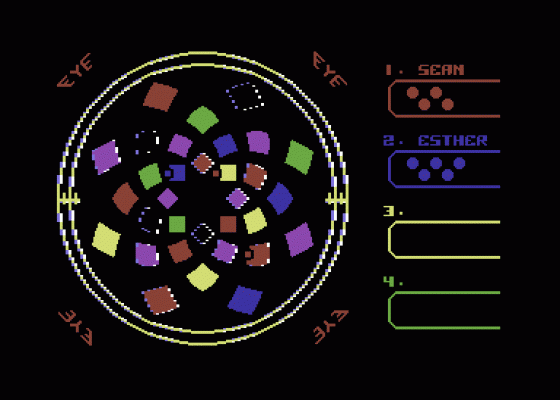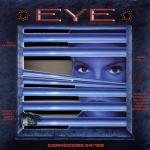
C&VG
 1st February 1988
1st February 1988
Author: Paul
Publisher: Endurance Games
Machine: Commodore 64/128
Published in Computer & Video Games #76
Hey, cosmic man!
Hey, cosmic, man. Pretty colours all moving about, in ever-changing spirals. This is weird.
But stick with it, because Eye - based on this year's big board game smash - is confusing at first sight, simple to learn once you actually start playing and has that hook, hook, hookability - to keep you playing for eons.
If you get Eye for Christmas - either on computer or board game - the whole family will have a fun time.

As I said before, I didn't really understand the game until I started playing and the realisation suddenly dawned. It's basically a simple idea, much easier than chess to learn, but just as complex in its endless strategies.
But before describing the aim of the game, it's best to know what the board is.
The board consists of 32 coloured squares formed by two spirals within a circle. There are eight different colours each having four squares in view at any one time. By rotating the spirals it is possible to change the visual position of the squares of each colour. The position of the squares of each colour is called a pattern and by rotating the spirals you will notice there are four patterns, the Long spiral, the Short spiral, the Straight line and the Circle. Got it? You will, don't worry.

Also shown on the board is the player's Status box. This is used initially to indicate the number of counters to be placed by a player during set-up and afterwards to indicate "controlled colours" that a player may capture during the course of a game.
Now the object of the game is to get the required number of your counters onto the corresponding colour squares on the game board. Simple, eh?
Up to four people can play.
The winner of a two player game is the person who manages to get four of his counters onto his colour pattern on the board. Each player starts with six counters and takes it in turn to place one piece at a time onto an unoccupied square on the board.
A move is made either by moving a player's own counter to an adjacent square or by moving one of the spiral wheels clockwise or anti-clockwise. A player on their turn may move their counters and/or turn the wheel in any combination or direction up to the total number of moves allowed. A player is not allowed to place a counter on an already occupied square, nor to "jump" over occupied squares.
The rules for three or four players are much the same.
You can see the complexities that are already beginning to build from a simple idea. All that's left to say is play the game.
And don't forget to check out the packaging. It's probably the most lavish we've seen for a reasonably priced game.
There is also a book on the market which, apparently, includes all the spiral patterns that can be made on the board game. So it looks as though there's an Eye industry starting to grow. We've even heard that Eye II could be in the offing.



